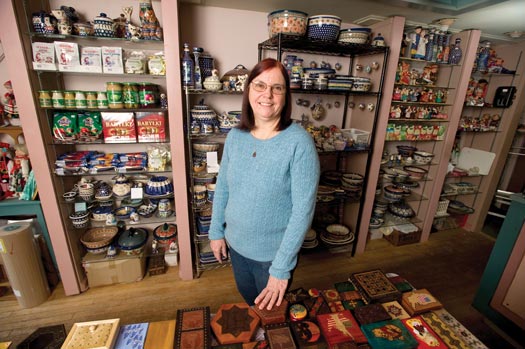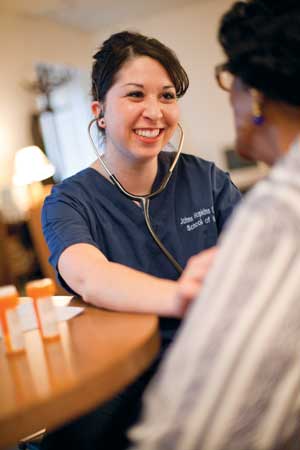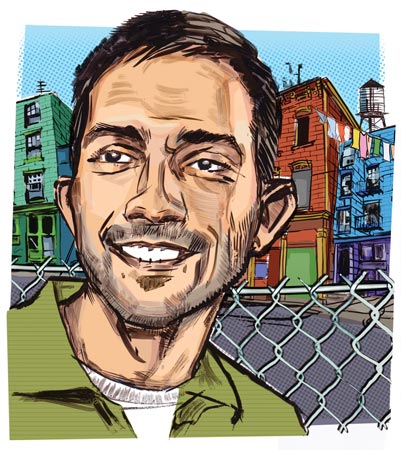By Stephanie Shapiro
Photos by Christopher Myer
Johns Hopkins nurse leaders are crossing Wolfe Street, integrating nursing education, research, and practice
 For just over an hour on a gray winter afternoon, Martha N. Hill, PhD, RN, FAAN, Dean of the Johns Hopkins University School of Nursing, and Karen Haller, PhD, RN, FAAN, The Johns Hopkins Hospital Vice President for nursing and patient care services, seize the rare opportunity to sit down together and compare notes from their respective sides of “the street.”
For just over an hour on a gray winter afternoon, Martha N. Hill, PhD, RN, FAAN, Dean of the Johns Hopkins University School of Nursing, and Karen Haller, PhD, RN, FAAN, The Johns Hopkins Hospital Vice President for nursing and patient care services, seize the rare opportunity to sit down together and compare notes from their respective sides of “the street.”
They settle in to a discussion of the culture of collaboration between the school and the hospital’s department of nursing, a culture that is essential in providing quality patient care and preparing for a future filled with challenges, from a severe nursing shortage to a faltering health care system.
The growing collaboration makes sense and comes naturally. “We sit on each other’s committees, and there are increasing numbers of nurses with joint appointments,” Hill says, naming just a few of the ways the street has narrowed.
It has been 120 years since nursing education first began within The Johns Hopkins Hospital and 25 years since the school opened as a division of the university. Much has changed. Yet, as they forge a lasting partnership, Hill and Haller build upon the common ground of an institutional alliance born in 1889.
How would you describe your shared vision of “Hopkins Nursing?”
MH: I think it’s a co-dependency. Faculty must understand the practice world and adapt to prepare graduates for practice today through our formal academic program. The partnership also helps with recruitment of both the staff nurses who teach and the students who join the hospital staff. It’s mutually beneficial and sets standards at a high level on both sides.
The intersection occurs most clearly in the area of continuing education: the non-credit career development that we all do through the Institute for Johns Hopkins Nursing.
How does the Institute for Johns Hopkins Nursing bridge JHH and JHU nursing?
MH: Our common goals to achieve excellence in research and scholarship, teaching, practice, and service remain robust with the support of continuing education programs that incorporate Hopkins nursing advances and that extend to nurses who practice here, nationally and globally.
KH: There is increasing emphasis on this campus as an academic nursing center and the Institute, along with The Johns Hopkins Hospital nursing department and the nursing school, make that concept a reality.
Is synergy automatic between the institutions of this academic nursing center?
KH: I think you have to work on creating that synergy. You have to work on being a partner. It’s like a marriage. Martha’s very busy; her faculty are busy and we’re busy. You have to nurture the partnership.
MH: Since the school reopened 25 years ago, there have been few if any alumni with leadership roles in the hospital. That is just now changing. The hospital nursing staff is automatically wired to be thinking about the school. We’re seeing more e-mail traffic across the street, more conversation, and more collaboration. And I think that is having a ripple effect through the hospital.
How does nursing fit into the larger picture of the Johns Hopkins institutions?
MH: Opportunities abound for cross-disciplinary scholarship. Students can move quite freely from school to school to school. For example, our new geriatric nursing group started and word began to spread. Now students come to join our student Geriatric Interest Group from medicine and public health, and they come from the Homewood campus. Through the new Carey Business School, we will continue to offer an MBA in the business of nursing and add new programs.
KH: I think the patient safety movement demands interdisciplinary teamwork. That’s really sped up our efforts at collaboration. We all have to be on the same team now, and you can’t come to that team as the lowest educated person on it and command respect. You have to come with the education, the understanding of the data and research that make you a full member of the clinical team. That’s why a university education is critical and having a good proportion of nurses who have graduate degrees under their belt can drive change.
How does collaboration allow you to incorporate evidence-based practice in the hospital?
KH: We’ve been pushing hospital nursing staff to ask questions such as, “Why am I doing this?” or “What is the evidence behind what I’m doing?” We don’t have the research expertise to drive those questions to a reasonable answer, so Martha’s faculty and graduate students help us answer these questions.
How will you work together to achieve health care reform?
KH: We’re going to have to change the health care system. It’s too expensive, it’s not producing the outcomes we want, and it’s still not safe 10 years after the Institute of Medicine report urged reform. So change and change management are critical in moving forward. And the emphasis must be on data, we have got to measure what we’re doing. That’s where the research expertise developed in Martha’s programs comes in.
Describe a long-range program that ensures your partnership into the future.
MH: The school’s new degree, the doctor of nursing practice (DNP), prepares advanced practice nurses for systems-level change. They may care for one or ten, 100, 1,000 or 10,000 patients at a time, but they are leaders in the practice setting and they must understand change management, organization development and behavior, and finance. The degree benefits the leadership pipeline for the Hopkins health system.
KH: We’ve forged a wonderful collaboration in our efforts to respond to requests from nurse leaders in more than a dozen countries. For some of the projects, the faculty develop programs or curricula; other efforts are entirely on the hospital side, where we send nurses over to evaluate nursing practice and hospitals. Some projects require both academic and practice skill sets.
 In The Streets
In The Streets Celebrating Poland's Treasures
Celebrating Poland's Treasures The Foreigner
The Foreigner Understanding the Impoverished
Understanding the Impoverished Natural Asthma Remedies Could Pose Risks
Natural Asthma Remedies Could Pose Risks







